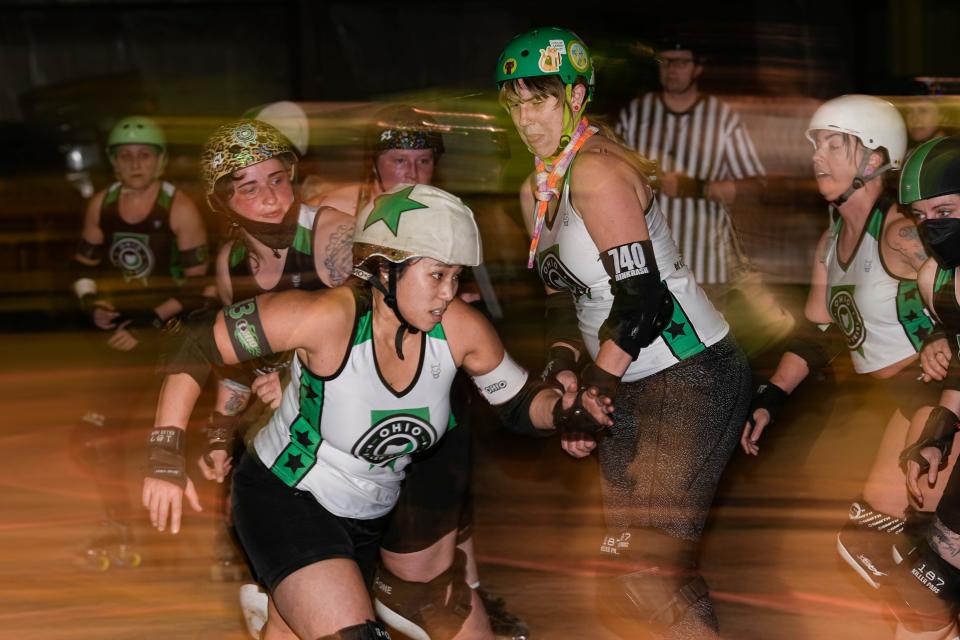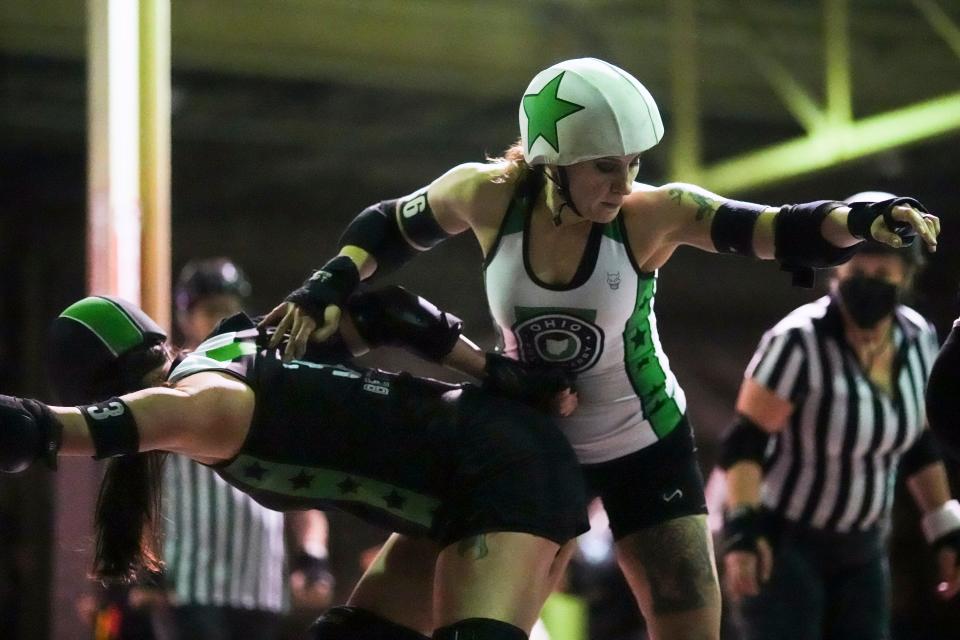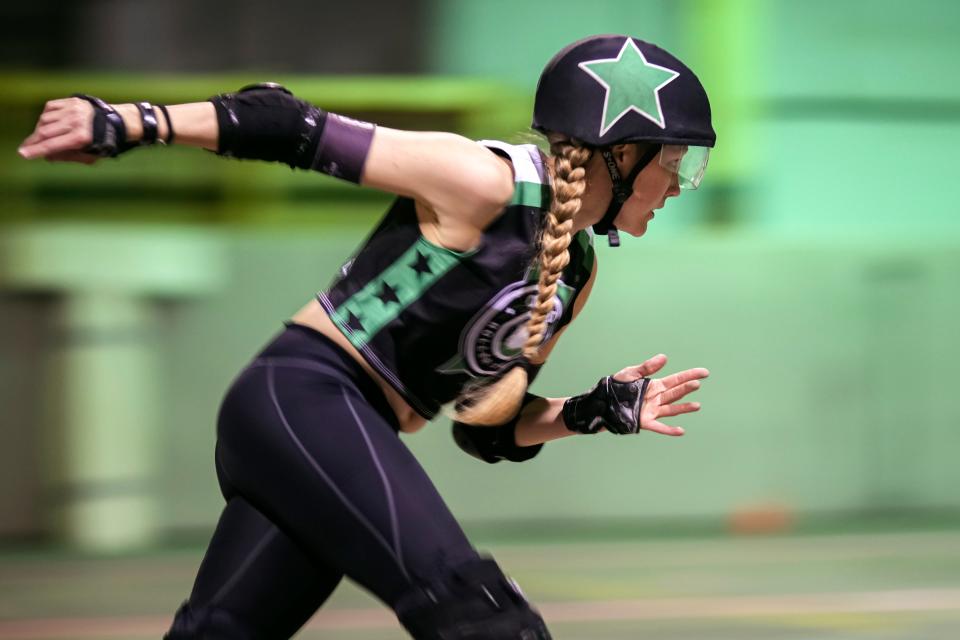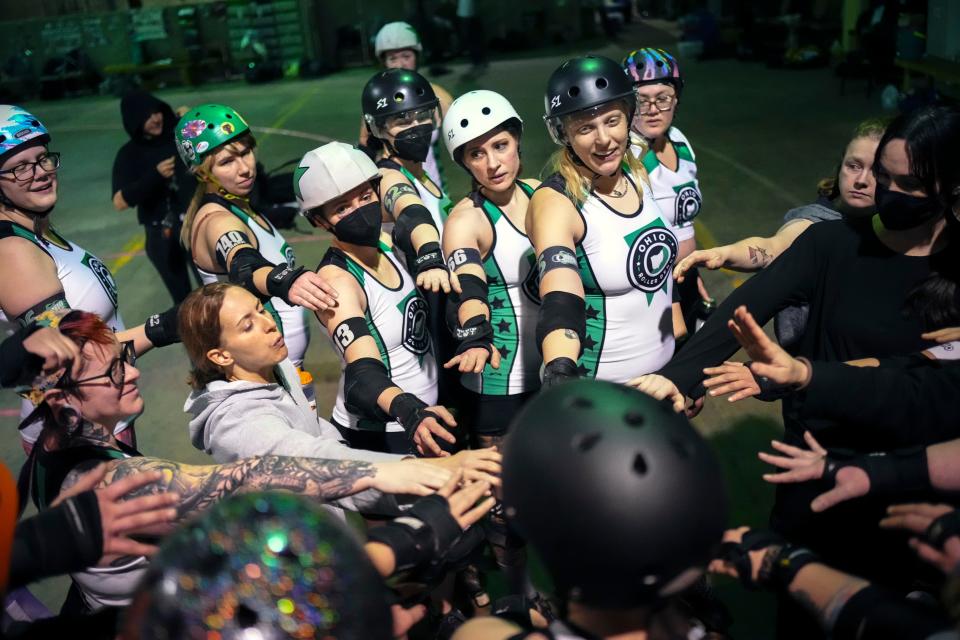Talkin' derby: In the rink with Columbus' Ohio Roller Derby league
Most people have heard of roller derby, but many view it as mere entertainment, thanks to the theatrical extravagance and choreographed slapstick violence that characterized women's derby of the 1970s.
But comparing the over-the-top antics of old roller derby to the modern incarnation of the sport — and yes, it is a legitimate, highly organized sport — is like comparing Olympic-style Greco-Roman wrestling to the WWE SmackDown.
Few people know that roller derby is a sanctioned sport governed by the Women's Flat Track Derby Association (WFTDA) and even fewer are aware that Columbus has had its own league, Ohio Roller Derby (OHRD), since 2005.

"It's a bit of a novelty for some. For older people, they think it's similar to what they've seen in the past," said league member "Sheepskate" (Miranda Inscho).
Inscho's teammate "Def Shepard" (Lauren Shepard), added, "It's not on ESPN or TV, so people don't know it's a sport."
Who are the members of Ohio Roller Derby?
Now 70 members strong, Ohio Roller Derby is made up of women from all walks of life, ranging from their early 20s to mid-40s. They are wives, mothers, LGBTQ+ individuals and an assortment of races, ethnicities, sizes, shapes and experience levels. Some are college students, others are educators, medical staff, engineers, artists and a laundry list of other professions.
Ohio Roller Derby has two competitive teams: the All Stars, who compete in internationally ranked game play as part of the Women's Flat Track Derby Association, and Gang Green, a developmental team of up-and-coming talent.
Some of the skaters are area natives, others hail from different cities around the state. At least one lives two hours away. And some, like Shepard and "Chainsaw" (Candace Moser), moved here expressly to skate with Ohio Roller Derby.
"I made the team on a Friday and found out I was pregnant on Saturday," Moser said, laughing.
Shepard skated with a league in Fort Wayne, Indiana, for one season before the pandemic lockdown. When the world reopened and fans resumed attending sporting events, she came to Columbus to join Ohio Roller Derby.

Team members who had never skated before went through the league's six-week Skating 101 program and/or its eight-week Recreational Program (OHRP), which offers multiple tiers of gameplay from low to full contact.
"Some people come from other sports, for example, hockey," Inscho said. "It's a mixed bag from people who have been skating since they were 2 years old — little rink rats — to people who are like Bambi on ice."
Ohio Roller Derby is run entirely by volunteers, including its announcers, marketers and officials; in many cases, players do double duty in these and other management roles. "Everybody uses skills from their daily lives, whether direct or tangential, to help run things," Moser said.
A perfect example of this is Inscho's job in the ticketing office for the Wexner Center for the Arts lending itself to her handling ticketing for the derby. "I call it my recreational part-time job," she joked.
Life in and out of the Ohio Roller Derby rink: a juggling act
How do the skaters balance work, school, families and other obligations with the rigorous demands of derby life, which includes at least two weekly practices, two monthly home games and two away games each month? It requires discipline, dedication, organization and a strong support system, they said.
"My husband is very supportive. He said, 'I'll do whatever you need me to do to help, even clean toilets," Moser said. "He's willing to do the weirdest, most banal jobs."
Solar eclipse soundtrack: 10 songs from Bonnie Tyler to the Beatles
Being a parent sometimes means derby practice is Bring Your Kid to Work Day. As soon as her daughter was old enough, Moser took to the rink with her in tow. "She was raised in roller derby. She loves it but has zero interest in playing. She wants to be a doctor."
Then there are the kids who do follow in their mothers' skate-steps, like "Ratchet" Rachel Dement-Wilson's daughters. "She lives in Dayton, plays for OHRD and her daughters play for a junior derby league in Cincinnati. It's crazy, but she makes it work," Moser said. "You have to want to do it."
"Some people come to practice straight from work," Inscho said. "It very quickly becomes your life. It's a time-consuming obligation and you have people depending on you to show up."

Roller derby 101: The basics
Because of its breakneck pace and trying to keep up with five players from each team speeding around all at once, roller derby can seem chaotic and complex to newbies. "There's so much going on and there's always something to see and analyze," Moser said.
However, once you get a handle on the positions, rules, strategy and play, it's relatively easy to understand.
As with any contact sport, flat-track roller derby is about offense and defense, with designated positions. "You have jammers, blockers and pivots who play two 30-minute halves," Moser explained. "Each half is divided into 'jams' of up to two minutes."
A jammer — the player with a star on her helmet — is the scoring player for the team who sprints around the track trying to pass her opponents as many times as possible.
"There are four blockers who try to stop the opposing team's jammer while helping their jammer get through the pack (the opposing team's blockers) to make a lap," Moser said.
Up-and-comers: Columbus Against the World to showcase local bands on April 5 at Newport Music Hall
The pivot, recognizable by the stripe on her helmet, is like a blocker with superpowers in that she's permitted to accept a star pass from the jammer, thus becoming the new jammer and gaining the ability to score points.
In the simplest terms, the objective is for jammers to pass or "lap" the members of the opposing team. A jammer earns a point for each opposing blocker she passes and an additional point for passing the other team's jammer.
Who are the fans of roller derby?
Roller derby is not a "one size fits all" sport. Just as there's no specific "type" of person who gets involved with Ohio Roller Derby, there's no "typical" derby devotee. Fans run the gamut from small children to older adults, and not all are local residents.
"My parents come from Tennessee for all my home games," Shepard noted.
Some players have even been elevated to star status by fans, Inscho said, naming "Bigg Rigg" (Tarah Briggs), a 4-foot-11 powerhouse of a jammer as something of a "local celebrity." Briggs even has a fan club on Instagram.
"She's really popular and she's really good," Inscho said. "Chainsaw is also a fan favorite."
Despite many people not aware of Ohio Roller Derby, their following is a faithful one, as evidenced by the fact that their home games usually sell out.
Is roller derby safe?
With full-body contact sports come the risk of injuries, to which Ohio Roller Derby skaters are no strangers. Inscho once sustained a mild concussion and Moser took an uncommonly nasty blow to the back and required surgery. But there are rules in place to ensure that play is as safe as possible.
Besides helmets, players wear knee and elbow pads, along with mouthguards. The WFTDA also has strict guidelines about what is and isn't allowed during games. It's legal for a skater to block opponents with their hips, rear and shoulders, but tripping and elbow jabs are not fair play — a misconception born of old-fashioned derby and perpetuated by movies like "Whip It."
Illegal actions will earn the offending skater 30 seconds in the penalty box, precious time in such a fast-action sport.

What's next for Ohio Roller Derby?
Fresh off back-to-back games in Ontario, Canada, and Buffalo, New York, the team will play its next home game on March 30 in the Lausche Building at the Ohio Expo Center, 717 E. 17th Ave. Doors will open at 4 p.m. and the first game (the All-Stars) will begin at 5 p.m. The second game (Gang Green) begins at approximately 7 p.m. Opponents have not yet been announced on the derby website.
Other home games are set for April 27, May 25 and June 15. The April game will be played in the Expo Center's Kasich Hall and the others will take place in the Lausche Building.
Ticket prices cost $16 general admission (plus $2.40 fee) and $10 (plus $1.42 fee) for children ages 8 to 12. Tickets also are sold in packs of four, six and 10; children 7 and younger are admitted for free.
Four more away games are also lined up, with the June 30 season ender pitting the All-Stars against the Black Rose Roller Derby in Hanover, Pennsylvania.
"Our next few games are important because we're trying to qualify for the North America-Northeast cup," Moser said, referring to the regional championships, which will be held May 17-19 in State College, Pennsylvania.
For more information about Ohio Roller Derby, visit ohiorollerderby.com.
This article originally appeared on The Columbus Dispatch: Ohio Roller Derby league skaters discuss the sport and rink life

